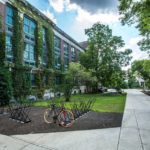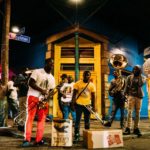New Orleans Plantation Tours: The Horrible and the Honest

When my sister and her boyfriend visited me in Louisiana, we knew we wanted to take part in one of the New Orleans plantation tours. My friend had already visited the Oak Alley Plantation, and her pictures looked pretty spectacular. It certainly was, but, we realized, not for the right reasons. Imagine a tour of a concentration camp where the overwhelming focus was on the lives of the Nazis, and where the guides wore Nazi uniforms. This should give you an idea as to how inappropriate the majority of the plantation tours in the South are.
The tour guides at Oak Alley Plantation were dressed in traditional clothes, with the intention of looking like slave owners. During the tour, the only information we were given was about the slave owners, while the only information we could find about slaves was on placards outside. My family and I definitely felt like this was not sufficient. Apparently, the majority of other plantation tours in the South are run like this as well. People are even able to get married at plantations, which to me, seems very strange, as these were places where human beings were abused and tortured.
New Orleans Plantation Tours: The Horrible and the Honest
When my parents and brother visited, we decided to check out a plantation tour, which emphasizes the lives of the slaves. We signed up for a tour at the Whitney Plantation, which just opened last year. We were disgusted to learn that it is the only plantation in Louisiana that focuses on the slaves.
When we arrived at the Whitney Plantation, it was incredibly hot and we covered ourselves in sun cream. After about ten minutes, the heavens opened and we were completely drenched. All we could think about was how difficult these weather conditions would have been for the slaves who worked from dawn until dusk.
Imagine a tour of a concentration camp where the overwhelming focus was on the lives of the Nazis, and where the guides wore Nazi uniforms.
At the entrance of the museum, there was an image of Ile de Goree in Senegal, where many slaves were transported overseas to plantations such as the Whitney. I did my gap year in Senegal and visited Ile de Goree several times, so it was incredible to have seen both sides of this horrific historical journey.
Our tour guide at the Whitney was extremely knowledgeable and told us exactly how the conditions were for the slaves. We were each given a lanyard with the image of a child slave, information about them that included how old they would have been today. Around the museum there were sculptures of these children created by the artist, Woodrow Nash, which were very moving.
Our tour guide took us around memorial spaces, then to the slaves’ quarters, and lastly, to the Big House. We entered the Big House through the back door, as the slaves would have done. Our guide informed us that culinary students from Dillard University visited the plantation and cooked in the kitchen there, using the same methods that the slaves would have done, so they could experience what it would have been like.
New Orleans Plantation Tours: The Horrible and the Honest
On the Louisiana Travel website, they discuss why bonfires are held as a tradition on Christmas Eve along the levees – supposedly lighting the way for Father Christmas. The website states, “Some historians believe they are a carry-down of an ancient European tradition where bonfires initially honored successful harvests and later from Christianity (south Louisiana was originally a French colony, and residents remain predominantly Catholic).”


People are even able to get married at plantations, which to me, seems very strange, as these were places where human beings were abused and tortured.
However, our tour guide rolled her eyes at this misconception, claiming that the tradition definitely originated from slavery. Before the time of year when slaves most commonly tried to escape the plantation, plantation owners would have lit their route so that they could have been seen and captured more easily. In addition, the fires would have deterred and intimidated slaves who wanted to escape. This burning across the levees has now been transformed into a twisted Christmas tradition.
When slaves were caught after trying to escape, they were branded on their forehead or cheeks with a fleur de lis, the symbol of New Orleans, and of Louisiana. This would mark them as troublemakers.
The museum is undergoing lots of developments and there are plans to create others like it in the South. I hope to return in a few years and see how it has progressed.
Photos for New Orleans Plantation Tours: The Horrible and the Honest by Ciara Cohen-Ennis and top photo by Unsplash.









Great and insightful post, Ciara! Plantation weddings are a truly disturbing trend in the South, and I wish more people would realize how inappropriate they are.
Thank-you, Katy!
Your blog post is thought provoking, but it strikes me as coming from someone who has heard only a portion of the truth. As a person of Caucasian Cajun heritage living in Louisiana, I would politely ask to share some facts with you, in the spirit of clearing up any misperceptions:
1) My family has been here since the late 1700s. My ancestors were never slave holders, but we do have a recorded tradition of lighting Christmas eve bonfires as early as the early 1800s. So did many of our neighbors. We never once lit those bonfires for anything to do with slavery. I cannot speak for any other family, but I have never heard this correlation between slavery and bonfires before.. ever.
2) While I agree that many southern US plantations have not told the story of slavery well (or at all) in the past, almost all of them have incorporated significant elements of slavery into their tours. But, like much of history, that is not the only story with important lessons to be learned from.
3) Your facts regarding the wonderful Whitney Plantation seem mis-guided. They are the only plantation museum dedicated *solely* to telling the story of slavery, and they do a wonderful job. However, they are not the only plantation that shares a frank discussion about slavery, as you imply.
4) The only wedding I have attended at a plantation was for a friend, who is African American and *chose* to have her wedding there. She is free to choose where she wants to have her wedding, and I think we should celebrate that freedom. If she chooses to have her wedding there, who are you to be off-put at her decision? I was also told by Whitney Plantation that they have had weddings there, as well, but I did not witness that first hand.
5) In Germany, they still study the history during the Nazi era, so that lessons of the past are not forgotten, and the mistakes of history are not repeated. Studying that history is not the same as celebrating that history. In that light, studying the history of once-slave-holding Louisiana, and learning from the lessons of the past, is still important. That is not the same as celebrating the history of slavery. While I agree that some of the plantations in the South are little more than tourist attractions, most of the ones between New Orleans and Baton Rouge have an education mission, and I would like to learn any lessons from the past that we can, and that includes good and evil.
6) As a history buff, I have visited 18 southern US plantations from Virginia to Tennessee to Louisiana. As far you purported, you only visited two in Louisiana. Yet, you still feel educated enough to declare “how inappropriate the majority of the plantation tours in the [US] South are.” How many exactly have you visited, and how did you come to that conclusion? (You list no other ones on your travel blog.)
If you wish to educate yourself more, perhaps you can start with England’s (your home country) participation in the Atlantic Slave Trade. I won’t assume because you are educating yourself about that part of your heritage, that you are celebrating it.
http://www.nationalarchives.gov.uk/slavery/pdf/britain-and-the-trade.pdf
Hi Nancy,
Thank-you for your comment.
1) Traditions can be changed and I am sure that you and your family do not partake in the Christmas eve bonfires knowingly because of slavery. I merely pointed out a link that my tour guide informed me of at Whitney. You may not have heard of it before, as I may not have heard of some of the information you’re telling me before. This does not necessarily mean that it is inaccurate.
2) As I mentioned in the article, Oak Alley (and I’m sure many other plantations) do give some information about slavery, however it was not in the main tour. It is true, as you say, that other lessons can be learned from different parts of history. However, when visiting a plantation, I believe that most people are more interested in learning about slavery than about the family history of slave owners.
3) I was informed while at Whitney, and when looking online, that they are the only plantation with a focus on slavery and that is what I said in the article. In Oak Alley, the information about slavery is only written and not passed on by a tour guide.
4) I am not sure if the Whitney Plantation has weddings. Your friend of course has the right to choose to have her wedding wherever she wants. I personally just find it rather shocking that people would want to celebrate their wedding at a plantation considering their dark history.
5) At no point in my article did I say that studying history is the same as celebrating history. There is not enough information given about slavery in the plantations! I would like to have been given the opportunity to study it further and learn more.
6) You are correct in assuming that I have only visited two plantations, although you have undoubtedly visited more than me, I don’t think that this means that I cannot make comments about what I experienced. I only lived in New Orleans for one year. I have merely heard that the other plantations in the South do not have a focus on slavery and hold weddings. I consider this to be inappropriate. We obviously have different ideas about what is inappropriate.
7) I am of course aware that England (which is not my home country, I am actually from Wales) played a big role in the slave trade as well. I am disappointed that you seem to have misinterpreted my article, considering you think that I am saying to educate oneself about slavery is to celebrate it. This is clearly not the case.
Kind regards,
Ciara
Beautiful piece. Thank you, Ciara, for shedding light on how insane the majority of these tours are, and also, the one that is doing them right.
Thank-you very much!